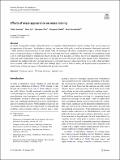| dc.contributor.author | Semizer, Yelda | |
| dc.contributor.author | Yu, Dian | |
| dc.contributor.author | Wan, Qianqian | |
| dc.contributor.author | Balas, Benjamin | |
| dc.contributor.author | Rosenholtz, Ruth | |
| dc.date.accessioned | 2025-01-27T19:04:43Z | |
| dc.date.available | 2025-01-27T19:04:43Z | |
| dc.date.issued | 2025-01-10 | |
| dc.identifier.uri | https://hdl.handle.net/1721.1/158073 | |
| dc.description.abstract | As mazes are typically complex, cluttered stimuli, solving them is likely limited by visual crowding. Thus, several aspects of the appearance of the maze – the thickness, spacing, and curvature of the paths, as well as the texture of both paths and walls – likely influence the performance. In the current study, we investigate the effects of perceptual aspects of maze design on maze-solving performance to understand the role of crowding and visual complexity. We conducted two experiments using a set of controlled stimuli to examine the effects of path and wall thickness, as well as the style of rendering used for both paths and walls. Experiment 1 finds that maze-solving time increases with thicker paths (thus thinner walls). Experiment 2 replicates this finding while also showing that maze-solving time increases when mazes have wavy walls, which are likely more crowded, rather than straight walls. Our findings imply a role of both crowding and figure/ground segmentation in mental maze solving and suggest reformulating the growth cone models. | en_US |
| dc.publisher | Springer US | en_US |
| dc.relation.isversionof | https://doi.org/10.3758/s13414-024-03000-7 | en_US |
| dc.rights | Creative Commons Attribution | en_US |
| dc.rights.uri | https://creativecommons.org/licenses/by/4.0/ | en_US |
| dc.source | Springer US | en_US |
| dc.title | Effects of maze appearance on maze solving | en_US |
| dc.type | Article | en_US |
| dc.identifier.citation | Semizer, Y., Yu, D., Wan, Q. et al. Effects of maze appearance on maze solving. Atten Percept Psychophys (2025). | en_US |
| dc.contributor.department | Massachusetts Institute of Technology. Computer Science and Artificial Intelligence Laboratory | en_US |
| dc.contributor.department | Massachusetts Institute of Technology. Department of Brain and Cognitive Sciences | en_US |
| dc.relation.journal | Attention, Perception, & Psychophysics | en_US |
| dc.identifier.mitlicense | PUBLISHER_CC | |
| dc.eprint.version | Final published version | en_US |
| dc.type.uri | http://purl.org/eprint/type/JournalArticle | en_US |
| eprint.status | http://purl.org/eprint/status/PeerReviewed | en_US |
| dc.date.updated | 2025-01-12T04:14:49Z | |
| dc.language.rfc3066 | en | |
| dc.rights.holder | The Author(s) | |
| dspace.embargo.terms | N | |
| dspace.date.submission | 2025-01-12T04:14:49Z | |
| mit.license | PUBLISHER_CC | |
| mit.metadata.status | Authority Work and Publication Information Needed | en_US |
